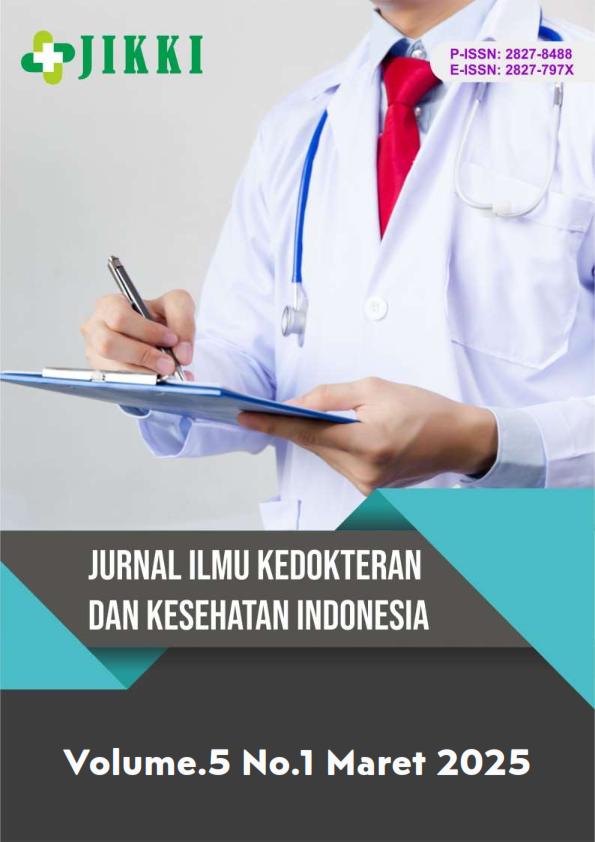Evaluasi Formulasi Sediaan Floating Mikroenkapsulasi yang Mengandung Ekstrak Etanol Daun Pepaya (Carica Papaya L.)
DOI:
https://doi.org/10.55606/jikki.v5i1.7052Keywords:
Floating, Microencapsulation, Moisture Content, Papaya Leaf, StabilityAbstract
Microencapsulation is a technology that uses controlled release of active ingredients to increase bioavailability and reduce gastrointestinal irritation. This study aims to evaluate the microencapsulation formulation of ethanol extract of papaya leaf (Carica papaya L.) by testing its stability, moisture content, and floating in the stomach and intestinal medium. Mardikasari et al (2020) showed the release of chitosan-alginate microencapsulation of 8,811 mg/L (acid) and 79,908 mg/L (base). Microencapsulation was performed by adding sodium alginate and chitosan as polymers, CaCl2 as a cross-linking, and three variations of extract concentration in F1 without extract, F2 of 0,25%, F3 of 0,5%, and F4 of 0,75%. The results showed that all formulas remained stable during the storage cycle in terms of color, aroma, taste, and texture. The average moisture content of the microencapsulated formulations was 24%, 20,5%, 28%, and 18,7%. The microencapsulated preparations were able to maintain their stability in the acidic conditions in the stomach, but showed a decrease in floating under acidic conditions in the intestine.
References
Agung, I. D., Meisha, G., Nengah, N., Fatmawati, D., & Sri, N. N. (2021). Jurnal Medika Udayana, 10(2), 6–12.
Aminah, S., & Hersoelistyorini, W. (2021). Review artikel: Enkapsulasi meningkatkan kualitas komponen bioaktif minuman instan. Prosiding Seminar Nasional UNIMUS, 4, 1869–1882.
Annissya, W. P., Lusi, N., Abdul, A., & Rian, J. A. (2024). Formulasi dan uji stabilitas krim. Pharmacoscript, 7(2), 219–231.
Aqsyal, M., & Mardiyanti, S. (2023). Uji stabilitas krim antibakteri ekstrak rimpang jahe gajah (Zingiber officinale Roscoe). Jurnal Farmasi dan Farmakoinformatika, 1(1), 76–83.
Desai, N., Rana, D., Salave, S., Gupta, R., Patel, P., Karunakaran, B., Sharma, A., Giri, J., Benival, D., & Kommineni, N. (2023). Chitosan: A potential biopolymer in drug delivery and biomedical applications. Pharmaceutics, 15(4). https://doi.org/.
Erviana, Masniati, Masita, Taufik, M., & Kurnia, H. (2023). Gambaran pengetahuan keluarga tentang pemanfaatan tanaman obat keluarga. Jurnal Promotif Preventif, 6(5), 777–785.
Halawa, K. M., Sitanggang, E. J., Napitupulu, R., & Sibuea, C. V. (2024). Kadar Interferon Gamma (IFN-γ) mikroenkapsulasi MSC-CD34+ dengan coating: Studi preliminari terapi seluler MDR-TB. Ibnu Sina: Jurnal Kedokteran dan Kesehatan, 23(2), 121–128.
Hidayah, T. N., Djaenudin, D., & Lubis, N. (2021). Enkapsulasi probiotik Lactobacillus sp. menggunakan... [Nama jurnal tidak disebutkan], 6(2), 1814–1825.
Kusmayadi, A. (2021). Pengaruh formulasi mikroenkapsulasi ekstrak kulit manggis terhadap kadar air dan sebaran jamur pada lama penyimpanan yang berbeda. Agrointek: Jurnal Teknologi Industri Pertanian, 15(1), 293–299.
Maharani, P. F., & Susanti, R. (2022). Aplikasi kitosan cangkang rajungan (Portunus pelagicus) dalam ransum terhadap profil lipid darah itik. Life Science, 11(2), 184–191.
Mardikasari, S. A., Suryani, Akib, N. I., & Indahyani, R. (2020). Mikroenkapsulasi asam mefenamat menggunakan polimer kitosan dan natrium alginat dengan metode gelasi ionik. Jurnal Farmasi Galenika (Galenika Journal of Pharmacy), 6(2), 192–203.
Na’imah, J., & Nasyanka, A. L. (2024). Potensi flavonoid dalam daun pepaya (Carica papaya L.) sebagai antiinflamasi secara in silico. Fullerene Journal of Chemistry, 9(1), 8–13.
Nasria, N., Tanra Tellu, A., & Nurdin, M. (2024). Analisis proksimat umbut rotan noko (Daemonorops robusta). Jurnal Inovasi Global, 2(3), 445–452.
Nurhayani, M., Rohmawati, A., & Kurniasari, L. (2020). Mikroenkapsulasi oleoresin kayu manis (Cinnamomum burmannii) metode spray drying dengan penyalut maltodextrin–susu skim. Jurnal Inovasi Teknik Kimia, 5(1), 12–16.
Oktavia, R., Rini, P., & Luthfiah, A. (2024). Pepaya sebagai substitusi daging sapi: Inovasi pembuatan dendeng menggunakan daun pepaya sebagai pengganti daging sapi. 3(1), 3–6.
Sari, D. P., Lestari, P. M., & Nining, N. (2022). Review: Komposit polimer pektin dalam sistem penghantaran obat. Majalah Farmasetik, 7(1), 1–17.
Sari, D., Arza, S., Fiona, F., Novita, N., Dermawan, B., & Ega, E. (2024). Analisis kadar air dan nitrit pada pati sagu. Journal of Food Security and Agroindustry, 2(1), 11–16.
Sari, S. K. (2020). Mikroenkapsulasi asam mefenamat dengan penyalut natrium carboxymethyl cellulose. 7–11.
Teheni, M. T., Nurwanti, R., & Syafriah, W. O. (2023). Penetapan kadar saponin ekstrak daun pepaya (Carica papaya Linn) menggunakan metode gravimetri. Jurnal Ners, 7(1),
Wardatun, S., Rustiani, E., & Damahyanti, O. (2020). Pengembangan mikrogranul mukoadhesif ekstrak kayu manis dengan kombinasi polimer karbopol dan gelatin. Jurnal Fitofarmaka Indonesia, 7(1), 9–15.
Wati, R. R., Sriwidodo, S., & Chaerunisa, A. Y. (2022). Peningkatan stabilitas fitokonstituen melalui pendekatan mikroenkapsulasi. Majalah Farmasetika, 7(1), 39.
Zahrani, U. T., Rahayu, I. D., Ulandari, A. S., Jl, A., Brojonegoro, S., & Meneng, G. (2025). Kandungan senyawa fitokimia dan aktivitas antibakteri ekstrak daun pepaya
Downloads
Published
How to Cite
Issue
Section
License
Copyright (c) 2025 Jurnal Ilmu Kedokteran dan Kesehatan Indonesia

This work is licensed under a Creative Commons Attribution-ShareAlike 4.0 International License.








